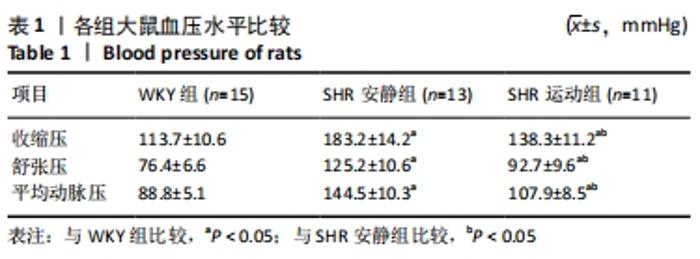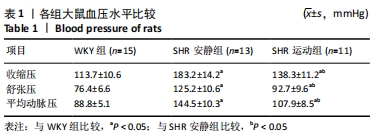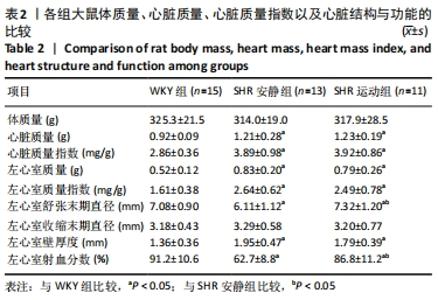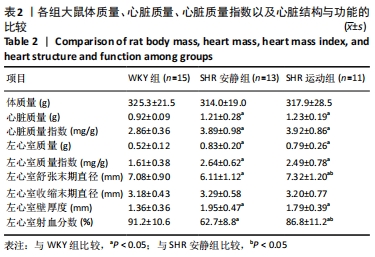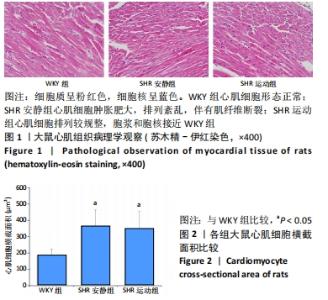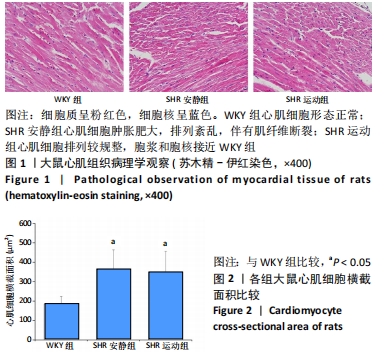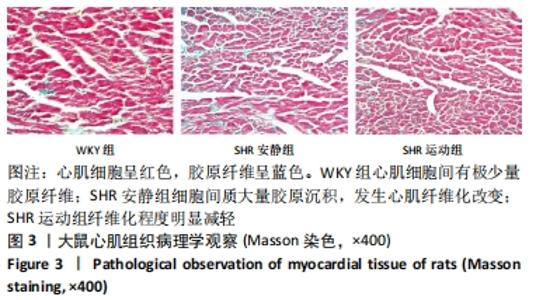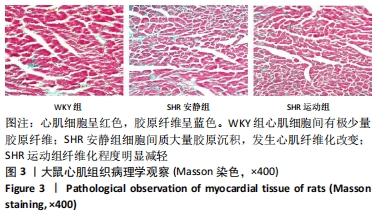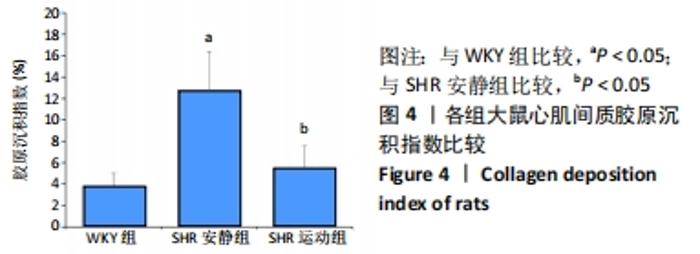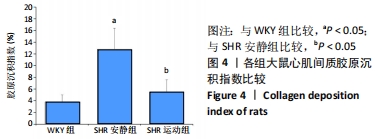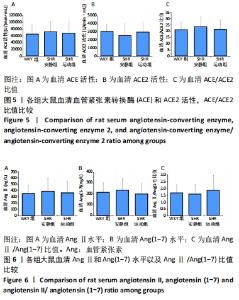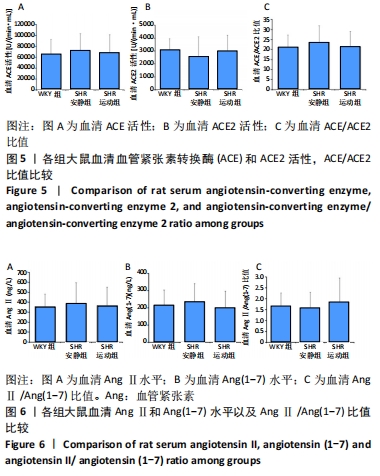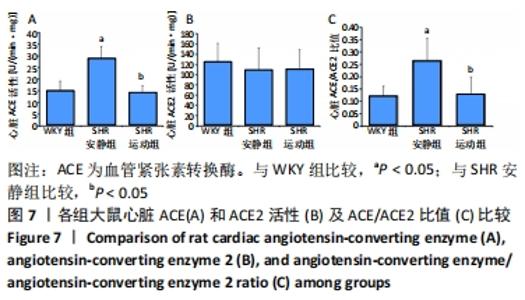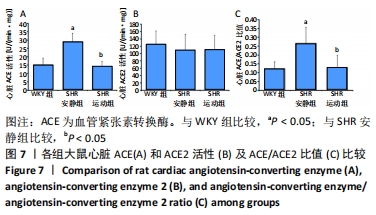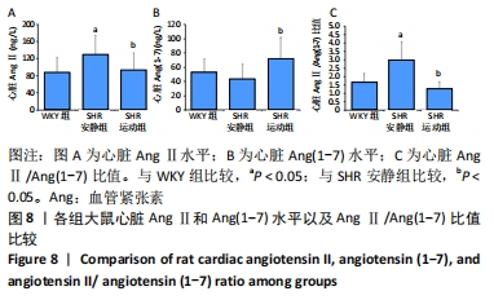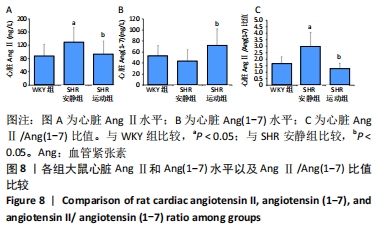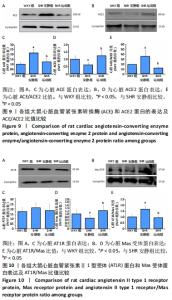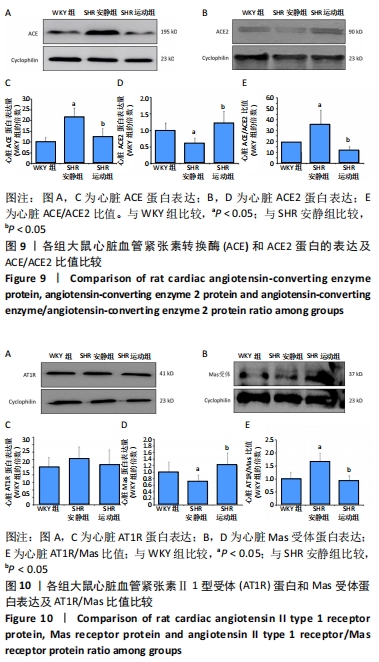Chinese Journal of Tissue Engineering Research ›› 2022, Vol. 26 ›› Issue (14): 2231-2237.doi: 10.12307/2022.488
Previous Articles Next Articles
Regulatory mechanism of aerobic exercise on cardiac remodeling in spontaneously hypertensive rats
Zhu Zheng1, Fu Changxi1, Ma Wenchao1, Ma Gang2, Peng peng2
- 1Department of Physical Education, Xuzhou University of Technology, Xuzhou 221018, Jiangsu Province, China; 2Department of Health Service, Logistics University of Chinese People’s Armed Police Forces, Tianjin 300309, China
-
Received:2021-06-03Revised:2021-06-23Accepted:2021-07-01Online:2022-05-18Published:2021-12-22 -
Contact:Peng Peng, MD, Lecturer, Department of Health Service, Logistics University of Chinese People’s Armed Police Forces, Tianjin 300309, China -
About author:Zhu Zheng, Master, Lecturer, Department of Physical Education, Xuzhou University of Technology, Xuzhou 221018, Jiangsu Province, China -
Supported by:the Natural Science Foundation of Tianjin, No. 17JCYBJC27400 (to PP)
CLC Number:
Cite this article
Zhu Zheng, Fu Changxi, Ma Wenchao, Ma Gang, Peng peng. Regulatory mechanism of aerobic exercise on cardiac remodeling in spontaneously hypertensive rats[J]. Chinese Journal of Tissue Engineering Research, 2022, 26(14): 2231-2237.
share this article
Add to citation manager EndNote|Reference Manager|ProCite|BibTeX|RefWorks
| [1] TOMEK J, BUB G. Hypertension-induced remodelling: on the interactions of cardiac risk factors. J Physiol. 2017;595(12):4027-4036. [2] TAKIMOTO-OHNISHI E, MURAKAMI K. Renin-angiotensin system research: from molecules to the whole body. J Physiol Sci. 2019;69(4):581-587. [3] VARAGIC J, FROHLICH ED. Local cardiac renin-angiotensin system: hypertension and cardiac failure. J Mol Cell Cardiol. 2002;34(11):1435-1442. [4] SANTOS R, OUDIT GY, VERANO-BRAGA T,et al. The renin-angiotensin system: going beyond the classical paradigms. Am J Physiol Heart Circ Physiol. 2019; 316(5):H958-970. [5] SANTOS R, SAMPAIO WO, ALZAMORA AC, et al. The ACE2/angiotensin-(1-7)/Mas axis of the renin-angiotensin system: Focus on angiotensin-(1-7). Physiol Rev. 2018;98(1):505-553. [6] PAZ OCARANZA M, RIQUELME JA, GARCÍA L, et al. Counter-regulatory renin-angiotensin system in cardiovascular disease. Nat Rev Cardiol. 2020;17(2): 116-129. [7] BESSA A, JESUS ÉF, NUNES A, et al. Stimulation of the ACE2/Ang-(1-7)/Mas axis in hypertensive pregnant rats attenuates cardiovascular dysfunction in adult male offspring. Hypertens Res. 2019;42(12):1883-1893. [8] LEWINGTON S, CLARKE R, QIZILBASH N, et al. Age-specific relevance of usual blood pressure to vascular mortality: a meta-analysis of individual data for one million adults in 61 prospective studies. Lancet. 2002;360 (9349):1903-1913. [9] LAURENT S. Antihypertensive drugs. Pharmacol Res. 2017;124:116-125. [10] THOMPSON G, DAVISON GW, CRAWFORD J, et al. Exercise and inflammation in coronary artery disease: A systematic review and meta-analysis of randomised trials. J Sports Sci. 2020;38(7):814-826. [11] JACOB S, KRENTZ AJ. Exercise prescription in patients with type 2 diabetes and coronary heart disease: could less be more?. Cardiovasc Endocrinol Metab. 2020;9(1):1-2. [12] TIPTON CM. The history of “Exercise Is Medicine” in ancient civilizations[J]. Adv Physiol Educ. 2014;38(2):109-117. [13] CORNELISSEN VA, FAGARD RH. Effects of endurance training on blood pressure, blood pressure-regulating mechanisms, and cardiovascular risk factors. Hypertension. 2005;46(4):667-675. [14] 袁国强, 秦永生, 彭朋. 有氧运动对自发性高血压大鼠心肌纤维化的影响及机制[J]. 天津医药,2020,48(2):100-104. [15] 袁国强, 秦永生, 彭朋. 高强度间歇运动对自发性高血压模型大鼠病理性心脏肥大的影响及机制[J]. 中国组织工程研究,2020,24(23):3708-3715. [16] 黄红梅, 胡宗祥, 刘昭强, 等. 长期高强度间歇训练加重自发性高血压大鼠心肌纤维化[J]. 中国运动医学杂志,2020,39(8):615-625. [17] 范朋琦, 秦永生, 彭朋. 不同运动方式对自发性高血压大鼠心脏重塑和运动能力的影响[J]. 现代预防医学,2018,45(23):4341-4345. [18] 孟宪欣, 管泽毅, 葛吉生, 等. 间歇运动干预自发性高血压大鼠病理性心脏肥大:运动强度与健康效应的关系[J]. 体育科学,2019,39(6):73-82. [19] MEDEIROS RF, GAIQUE TG, BENTO-BERNARDES T, et al. Aerobic training prevents oxidative profile and improves nitric oxide and vascular reactivity in rats with cardiometabolic alteration. J Appl Physiol (1985). 2016;121(1): 289-298. [20] CARMONA AK, SCHWAGER SL, JULIANO MA, et al. A continuous fluorescence resonance energy transfer angiotensin I-converting enzyme assay. Nat Protoc. 2006;1(4):1971-1976. [21] ROSA RM, COLUCCI JA, YOKOTA R, et al. Alternative pathways for angiotensin II production as an important determinant of kidney damage in endotoxemia. Am J Physiol Renal Physiol. 2016;311(3):F496-504. [22] SHENASA M, SHENASA H. Hypertension, left ventricular hypertrophy, and sudden cardiac death. Int J Cardiol. 2017;237:60-63. [23] OLDFIELD CJ, DUHAMEL TA, DHALLA NS. Mechanisms for the transition from physiological to pathological cardiac hypertrophy. Can J Physiol Pharmacol. 2020;98(2):74-84. [24] GEORGE K, WHYTE GP, GREEN DJ, et al. The endurance athletes heart: acute stress and chronic adaptation. Br J Sports Med. 2012;46 Suppl 1:i29-36. [25] NADRUZ W. Myocardial remodeling in hypertension. J Hum Hypertens. 2015;29(1):1-6. [26] MA ZG, YUAN YP, WU HM, et al. Cardiac fibrosis: new insights into the pathogenesis. Int J Biol Sci. 2018;14(12):1645-1657. [27] KYSELOVIČ J, LEDDY JJ. Cardiac fibrosis: The beneficial effects of exercise in cardiac fibrosis. Adv Exp Med Biol. 2017;999:257-268. [28] CHOI SY, CHANG HJ, CHOI SI, et al. Long-term exercise training attenuates age-related diastolic dysfunction: association of myocardial collagen cross-linking. J Korean Med Sci. 2009;24(1):32-39. [29] FILHO AG, FERREIRA AJ, SANTOS SH, et al. Selective increase of angiotensin(1-7) and its receptor in hearts of spontaneously hypertensive rats subjected to physical training. Exp Physiol. 2008;93(5):589-598. [30] FERNANDES T, HASHIMOTO NY, MAGALHÃES FC, et al. Aerobic exercise training-induced left ventricular hypertrophy involves regulatory MicroRNAs, decreased angiotensin-converting enzyme-angiotensin ii, and synergistic regulation of angiotensin-converting enzyme 2-angiotensin (1-7). Hypertension. 2011;58(2):182-189. [31] BOSNYAK S, JONES ES, CHRISTOPOULOS A, et al. Relative affinity of angiotensin peptides and novel ligands at AT1 and AT2 receptors. Clin Sci (Lond). 2011;121(7):297-303. [32] GOWRISANKAR YV, CLARK MA. Angiotensin II regulation of angiotensin-converting enzymes in spontaneously hypertensive rat primary astrocyte cultures. J Neurochem. 2016;138(1):74-85. [33] PATEL VB, ZHONG JC, GRANT MB, et al. Role of the ACE2/Angiotensin 1-7 Axis of the Renin-Angiotensin System in Heart Failure. Circ Res. 2016;118(8): 1313-1326. [34] WANG X, YE Y, GONG H, et al. The effects of different angiotensin II type 1 receptor blockers on the regulation of the ACE-AngII-AT1 and ACE2-Ang(1-7)-Mas axes in pressure overload-induced cardiac remodeling in male mice. J Mol Cell Cardiol. 2016;97:180-190. [35] NI J, YANG F, HUANG XR, et al. Dual deficiency of angiotensin-converting enzyme-2 and Mas receptor enhances angiotensin II-induced hypertension and hypertensive nephropathy. J Cell Mol Med. 2020;24(22):13093-13103. [36] LIAO W, WU J. The ACE2/Ang (1-7)/MasR axis as an emerging target for antihypertensive peptides. Crit Rev Food Sci Nutr. 2021;61(15):2572-2586. [37] FRANTZ E, PRODEL E, BRAZ ID, et al. Modulation of the renin-angiotensin system in white adipose tissue and skeletal muscle: focus on exercise training. Clin Sci (Lond). 2018;132(14):1487-1507. |
| [1] | Shui Xiaoping, Li Chunying, Li Shunchang, Sun Junzhi, Su Quansheng . Effects of aerobic and resistance exercises on brain-derived neurotrophic factor, nuclear factor-kappa B and inflammatory cytokines in skeletal muscle of type II diabetic rats [J]. Chinese Journal of Tissue Engineering Research, 2022, 26(5): 669-675. |
| [2] | Deng Shuang, Pu Rui, Chen Ziyang, Zhang Jianchao, Yuan Lingyan . Effects of exercise preconditioning on myocardial protection and apoptosis in a mouse model of myocardial remodeling due to early stress overload [J]. Chinese Journal of Tissue Engineering Research, 2022, 26(5): 717-723. |
| [3] | Wang Susu, Li Lifeng, Zhang Yimin. Visualization analysis on research progress and hotspots of exercise therapy for sarcopenia in older adults in recent decade [J]. Chinese Journal of Tissue Engineering Research, 2022, 26(14): 2223-2230. |
| [4] | Yuan Lifen, Cao Shuang, Sun Ting. Effect of angiotensinogen-targeted RNA interference in spontaneously hypertensive rats [J]. Chinese Journal of Tissue Engineering Research, 2021, 25(35): 5626-5631. |
| [5] | Lu Yi, Deng Wenchong. Regulation and difference of different exercise styles on brain structure and cognitive function [J]. Chinese Journal of Tissue Engineering Research, 2021, 25(20): 3252-3258. |
| [6] | Li Songtao, Li Xinyi, Song Yunfeng, Ning Jiayin, Ren Qiang, Yang Renxu, Peng Bo. Maxing Xiongting Mixture regulates factors relevant to lung reshaping and vascular remodeling of hypoxic pulmonary hypertension rats [J]. Chinese Journal of Tissue Engineering Research, 2021, 25(2): 274-280. |
| [7] | Chen Xinling, Wang Shenglan. Cell autophagy, pathway, regulation and its multiple correlations with pulmonary hypertension [J]. Chinese Journal of Tissue Engineering Research, 2021, 25(2): 311-316. |
| [8] | Li Zihan, Yin Wen, Sun Wei, Zhu Kun, Shen Di, Liu Yujia. An 8-week aerobic exercise promotes the function of voltage-dependent potassium channel in mesenteric vascular smooth muscle from obese rats [J]. Chinese Journal of Tissue Engineering Research, 2021, 25(17): 2630-2635. |
| [9] | Zhang Lei, Yan Yu, Liu Yin, Xu Long, Yang Xinglei, Liu Yujia. An 8-week aerobic exercise improves obesity-induced myocardial fibrosis: role of nuclear factor-erythroid 2 p45-related factor 2 pathway [J]. Chinese Journal of Tissue Engineering Research, 2021, 25(17): 2650-2656. |
| [10] | Cao Haixin, Wang Xiaomei . Aerobic exercise protects the rat brain against senile dementia induced by amyloid beta protein 1-42 [J]. Chinese Journal of Tissue Engineering Research, 2021, 25(11): 1675-1681. |
| [11] | Shui Xiaoping, Li Chunying, Cao Yanxia, Su Quansheng. Effects of aerobic and resistance exercises on endoplasmic reticulum stress-related proteins in diabetic peripheral neuropathy rats [J]. Chinese Journal of Tissue Engineering Research, 2021, 25(11): 1693-1698. |
| [12] | Ye Quanying, Chen Qisheng, Li Yanwen, Wang Ting, Chen Xiaoyan, Yue Yun. Effect of cassia seed aqueous extract on blood pressure level in N-nitro-L-arginine-methyl ester induced hypertensive rats [J]. Chinese Journal of Tissue Engineering Research, 2021, 25(11): 1705-1711. |
| [13] |
Li Ying, Lin Wentao, Weng Xiquan.
Effects of different exercise intensities on visfatin level and glucose metabolism in type 2 diabetic rats [J]. Chinese Journal of Tissue Engineering Research, 2020, 24(26): 4196-4200. |
| [14] |
Wen Shuangwei, Wu Qingmei.
Aerobic exercise combined with levothyroxine and vitamin D3 relieves osteoporosis in subclinical hypothyroidism rats [J]. Chinese Journal of Tissue Engineering Research, 2020, 24(26): 4118-4124. |
| [15] | Yuan Guoqiang, Qin Yongsheng, Peng Peng. High-intensity interval training for treating pathological cardiac hypertrophy in spontaneously hypertensive rats: effects and mechanisms [J]. Chinese Journal of Tissue Engineering Research, 2020, 24(23): 3708-3715. |
| Viewed | ||||||
|
Full text |
|
|||||
|
Abstract |
|
|||||
